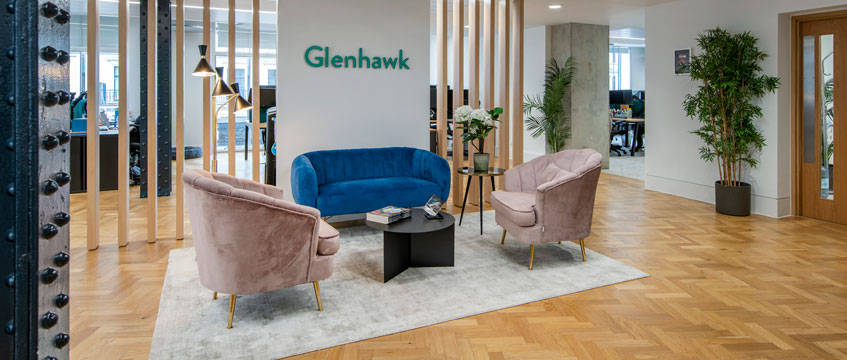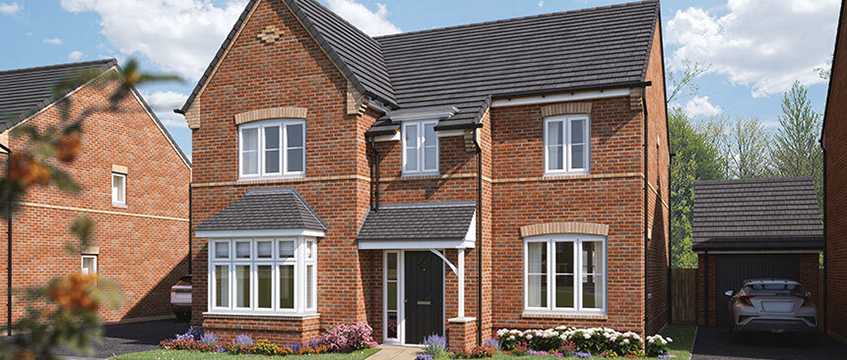Like many company bosses, Guy Harrington has spent most of the past two years grappling with a growing list of workplace conundrums. Accepting a prolonged period of homeworking was the first challenge for the chief executive of real estate bridge lender Glenhawk. Now he wants to encourage staff back into the office.
But Harrington is confident that he’s cracked it. Sitting in the company’s new offices at Mutual House at 70 Conduit Street, W1, just off Regent Street, the company founder says the freshly refurbished space is proving his belief that if the office is welcoming, people won’t want to leave.
“That sounds like the Las Vegas casino with no clocks and darkness,” Harrington says, catching himself. “But the reality is you want it to be a place where, in a post-Covid environment, you enjoy coming to, it’s not a chore, and you draw people in.”
Escaping the warren
Until February, Harrington and colleagues had worked a short walk away on Albemarle Street. That building was beautifully designed, he says, but its layout had always been clumsy and started to look worse once the pandemic hit. “The biggest problem we had was it was split across two buildings,” Harrington says. “It was a rabbit warren space. You had lovely design and features, but you had four rooms on one side, five or six rooms on the other, and it was very divided. A lot of tight corridors in which you walk by people – it wasn’t Covid-friendly.”
With the lease up early this year, Harrington decided to make a break. “Commercial rents had taken a hit at that time, because we were on a third wave [of Covid],” he recalls. “It was on the run-up to Christmas. No one was taking [offices] and I thought, ‘Well, what a great time to take space’.”
Glenhawk tasked designers at Peldon Rose with helping the company flesh out an initial design for the new space, which at about 4,000 sq ft is more than double the size of what it had leased on Albemarle Street. The office – the freehold to which is owned by the Crown Estate – is well-lit and roomy, allowing the company to have its underwriting team seated separately from the quieter operational team. Breakout areas abound and a large kitchen allows for socialising – including the now standard beer tap.
Jonathan Dawes, head of Peldon Rose’s SME division, works with myriad clients trying to work out what a modern office needs to look like as companies adapt to post-pandemic working practices.
“All organisations that we’re speaking to want more of a hybrid base to work from,” Dawes says. “But [the challenge] is understanding that if occupancy is at 65% and 35% is on a more agile basis, what does that equation look like? There will be spaces that are geared towards people as opposed to more personal space. Gone are the days when we were all working on a pedestal at our own desk. There’s now a much bigger emphasis on the purpose of coming into the office, creating those collaboration areas [to encourage] those fortuitous moments of engagement that happen when we get together as a team.”
When you invest in your people, you invest in your space… You give them a great space, they give you great work back
Like Harrington, Dawes says the emphasis must now be on giving people a reason to come back into the traditional workplace.
“The genie is out of the bottle – we can work from home, that has been demonstrated,” Dawes adds. “But what have we lost as part and parcel of that? This was very much about creating an environment that people wanted to be in and wanted to come to. You know that old adage, ‘build it and they will come’, Field of Dreams – well it was very much like that for us. It was about creating the magnet that would draw people in here.”
Need versus want
Glenhawk’s leaders have had to rethink many assumptions about homeworking versus the office since the first outbreak of Covid-19. “When the pandemic hit, I was really against homeworking,” Harrington says. “I felt, maybe selfishly, that there would be a lack of efficiency, there would be communication problems, and the growth of the business would slow during a period of time when we needed it to continue either at a plateau or a slight growth. It was hard for me mentally to adapt to it.”
But over weeks and months, Harrington was won around. “We were on Teams and Zoom and it was OK,” he adds. “I got used to it and after about three months I thought, you know what? People can work well from home and you don’t need to be in an office.”
And so Harrington has since been focused on why people would want, rather than need, to be in the office. He doesn’t expect occupancy to return to what it once was for some years – “[Real estate agents] won’t admit that, but I’m sure deep down most are thinking it.”– and currently has between 20 and 30 of Glenhawk’s 45 team members back in on a good day. But that figure is rising. And, importantly, as the company looks to add more to its headcount, Harrington has found a better office works wonders for attracting talent.
“Some of our rivals are working from home remotely completely, and we’ve got people coming to us, mainly younger people, who are leaving their job because they want to work in an office,” he says.
“This space has been brilliant for attracting new talent in the post-Covid environment, and that’s even more important now. When people come in for interviews, I say, what’s the draw? What do you want out of a place to work? And a lot of it comes down to the environment. Not having mouldy carpet tiles or working in a low or ground floor office. They want somewhere that feels good. And for me to invest in this is for the team. We could have easily spent far less in a different office and not attract the talent. But when you invest in your people, you invest in your space… You give them a great space, they give you great work back. It’s a simple formula that’s easy to get wrong.”
To send feedback, e-mail tim.burke@eg.co.uk or tweet @_tim_burke or @EGPropertyNews











